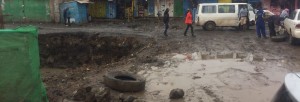
Whilst occasionally a rainy day may be a metaphor for life, a rainy day in Nairobi is more often associated with muddy water in motion, deep puddles on the road and endless traffic jam in every corner of the city. In more serious instances, heavy rainfalls which turns into a destructive flood will lead to an outbreak of cholera due to contamination of drink water, disrupted learning for school kids and homeless families whose house is submerged under the water.
Nairobi experiences two distinct rainy seasons throughout the year – the “long rainy” season in the spring months of March to May and the period of “short rains” between November to December. Currently, Nairobi is experiencing the period of “short rain” in which unpredictable and heavy rainfalls occurs frequently in the late afternoon or evening.
A rainy day will cause huge traffic jams in this already traffic-snarled capital. During the rainy season, many commuters will be stuck in traffic for hours as most city roads are flooded. Traffic jams are common in Kenya and are often caused by its badly maintained road network which was said to have worsenedinthe past several years. Last year, there was a shocking incident where Kenyans were stuck in a “50km” traffic jam stretched along the highway between Nairobi and Mombasa road following heavy rains and roadrepairs. Certain drivers stuck in the traffic apparently did not have the chance to eat, shower or even change clothes for more than a day in the vehicle! Furthermore, it will not be difficult to notice that the bus fares across town will hike up by more than 30% ona rainy day due to greater demand. Ironically, the price increase is generally more significant in the poorer neighbourhoods – amongst a population who is least able to cope with a price surge.
Earlier in the year, the city’s lacking infrastructure also led to a six-story house collapse during heavy rains killing more than 20 people. Walls crumbling and demolished buildings as a result of the floods are often blamed on the poor drainage systems in the city. As well as disposal of trash in drains which blocks water flow, the government are often criticised for corruptions and negligence in building development and safety-standard approvals. Some sources indicate that half of all homes in Nairobi are not fit for habitation and should be demolished.
French poet Paul Verlaine has once quoted: “Tears fall in my heart like the rain on the town.” Living in Nairobi, every time heavy rain falls, my heart also drops with a tear in my heart.